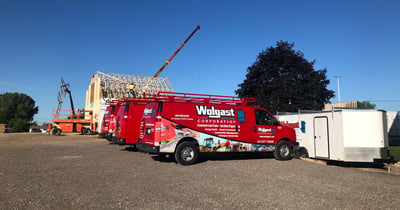
In order to maintain a stellar reputation as a professional contractor, speed, quick problem solving and meeting deadlines are critical. The biggest complaint and almost a disappointing anticipation in our industry is that a job will take longer than estimated. We strive to disprove that assumption on each and every project. Here’s one way that we do that.
After 75 years in the business, we understand that our projects run smoother and more efficiently when we rely on setting the schedules and completing the work ourselves for three specific trades. Having our own work crews to self-perform site work, concrete and carpentry is the best way to keep projects on track and with the quality that meets the standard of excellence we uphold. Some general contractors don’t have their own self-performed trades and they’re reliant on outsourced contractors’ availability to provide all services. In the summer and fall, when contractors’ schedules are typically full, subcontractors can be too busy to start site work, so the general contractor is dependent upon when the crew is available and the priority of their workload, which is also true for concrete and carpentry. With these trades in-house, we know our schedule and what we have in our pipeline, which allows us to manage workloads and progress better for our customers. Additionally, all our crews are trained “the Wolgast Way” and consistently perform to our standards in a timely manner, saving time and producing a quality product.
When using Design-Build construction, site work can start before plans are even complete. Having a site crew on staff helps us control the start of the project and gives us an advantage (sometimes by several months) over general contractors who have to be queued into a subcontractor’s lineup (out of their control). A concrete crew is also critical to keeping a job moving. Pouring slabs as soon as the site work is complete and having our crews scheduled in advance keeps us moving without costly stoppage. Similarly, we self-perform carpentry (rough, finish and millwork). Getting the framing erected on schedule and providing a reliable schedule for outsourced electricians, plumbers, HVAC, drywallers, then painters and flooring installers, etc. to get in and do their jobs when anticipated supports the rest of the trades to follow. These are the essential trades to keeping a job on track and the reason why we shoulder the expense of having them on our team. It’s more responsibility and risk to employ additional staff members when we could outsource the work, but the benefit of satisfied clients and expected outcomes outweighs costly delays and missed deadlines.
Currently, we’re expanding our carpentry team through our Carpenter Apprenticeship Program. It’s a four year program with a curriculum developed by the National Center for Construction Education and Research (NCCER). Through this program, we’re building a robust team of carpenters for the long-haul, which we expect to support us right through the current labor shortage. Accordingly, we have our clients’ interest and needs first and we’re persistently planning on how to best accommodate their scheduling, quality, and economic needs when it comes to building their commercial or industrial building.

